1.13: Psychedelic Music and the 1960s
- Page ID
- 168916
Psychedelic Music and the 1960s
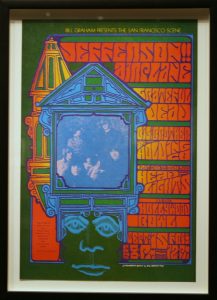
The 1960s were a time of rapid and dramatic change in American culture, and a counter-culture emerged with a major epicenter in San Francisco, CA. Inspired by the writers of the Beats like Jack Kerouac and Allen Ginsberg, the youth of the 1960s began looking for inspiration beyond those of materialism and money-making that were seen as emphasized by 1950s society. For many, a cultural rift had formed between young people and their parent’s generation. Some of the youth that identified as part of this new subculture became known as “hippies”. Characterized by casual clothing and long hair as well as simple and communal lifestyles, hippies created an alternative way of living that was reflected in the music of the counter culture. Another important aspect of this new subculture was the use of psychedelic drugs such as LSD which inspired the music of many bands. In attempt to achieve an exploratory quality comparable to the drug experience, some bands would perform lengthy improvisations that drifted into many different musical territories. Also, the Beatles early psychedelic musical experiments as well as developments in experimental classical music pointed the direction music was taking, providing inspiration for rock and pop groups that came from alternative sources. Many groups were inspired by Indian classical, jazz, experimental modern classical, as well as traditional American folk music unencumbered by commercialism. San Francisco became the mecca of the hippie movement as the city had a very relaxed and non-authoritarian atmosphere and had become the home of choice for many beat writers.
Exercise 1
Please read pgs. 35-45 in the article “‘Go Ask Alice’: Remembering the Summer of Love Forty Years On” by Anthony Ashbalt linked below. It gives an excellent overview of San Francisco and the burgeoning hippie culture during the period of 1965-68, and the role of the seminal figures like the Beats, music groups, specific events, psychedelic substances, concert promoters, etc, and the eventual diminishing of the movement.
Jefferson Airplane

More commercially successful than most other psychedelic groups in the 1960s was Jefferson Airplane. The group was fronted by vocalist Grace Slick. Their success was a result of shorter songs that often had standard rock beats as well as subject matter that emerged as statements of the hippie counterculture. “Somebody to Love” (1967) was a song about “free love” that became one of their early hits. Very simply put, free love is the concept of romantic relationships not tied by marriage, something that was new in the conservative cultural environment of the U.S. at the time. “White Rabbit” was more controversial. Based on Lewis Carrol’s Alice in Wonderland, the lyrics (featured below) contain many allusions to psychedelic drugs. The song consists of a gradual build in intensity, strange, chant-like vocals, and minimal accompaniment by the instruments that serve the vocals. The song features a well worn song form to provide something familiar to the listener, AABA.
One pill makes you larger
And one pill makes you small
And the ones that mother gives you
Don’t do anything at all
Go ask Alice
When she’s ten feet tall
And if you go chasing rabbits
And you know you’re going to fall
Tell ’em a hookah-smoking caterpillar
Has given you the call
Call Alice
When she was just small
When the men on the chessboard
Get up and tell you where to go
And you’ve just had some kind of mushroom
And your mind is moving low
Go ask Alice
I think she’ll know
When logic and proportion
Have fallen sloppy dead
And the White Knight is talking backwards
And the Red Queen’s off with her head
Remember what the dormouse said
Feed your head
Feed your head
Grateful Dead
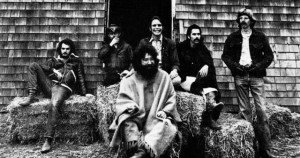
The Grateful Dead were formed in 1965 by Jerry Garcia (Lead Guitar), Bob Weir, (Rhythm Guitar), Pigpen (Keyboards), Phil Lesh (Bass) and Bill Kreutzman (Drums) in San Francisco. Originally an acoustic folk styled group, they eventually switched to electric instruments and became the epitome of psychedelic rock. Truly, no other group in 1960s popular music emphasized exploratory collective improvisation and live performance as much as the Grateful Dead. They blended many different types of music (folk, country, jazz, bluegrass, classical, free improvisation, etc.), creating a kaleidoscopic variety. Through improvisation when performing live they created smooth flowing and spontaneous sets of music, and every show was a unique performance, much like jazz.
One of the first opportunities for the Dead came from performing at the Acid Tests. The Acid Tests were a series of free form performance events organized by author Ken Kesey in which the participants (this included band members as well as audience members) were given LSD. Also, the Dead would often perform free concerts around San Francisco as well, setting up their gear on a flatbed truck in the middle of the street or a park and performing for whoever happened to be there. Gradually, through word-of-mouth, the group grew in popularity.
As the group became more popular, they were eventually signed to Warner Brothers and released their first album in 1967. By the time of their second and third albums, Anthem of the Sun (1968) and Aoxomoxoa (1969), the Dead were spending lots of time and money crafting complex and unusual sounds in the studio. Two new members joined around this time, Mickey Hart (2nd drummer) and Tom Constanten (keyboards), adding to the density of the sound. While their live performances were revered, these early studio efforts tended to lack the excitement of their performances. Also, the Grateful Dead’s experimental recordings were sometimes much longer than the average ‘radio-friendly’ song. “New Potato Caboose” (in Ch. 13 Listening Examples) features elaborate studio recordings mixed with a full band improvisation recorded live and spliced in as a second section to the song.
The studio albums had left the band owing money to Warner Brothers, so in 1970 they released the double live album Live Dead. This was in part to make back money they owed, but also to showcase the unique quality of a Grateful Dead concert. The first side of the double album showcased a single performance of a song called “Dark Star”, a piece with room for lengthy improvisation. A total of six minutes and four seconds of improvisation open the piece before the first vocal section occurs. Once the vocal section finishes, the band proceeds to experiment with sound, texture, loud and soft dynamics, rhythm/tempo, and tonality. The music is a far cry from the improvisation of a group such as Cream performing a 12-bar blues song like “Crossroads”. The dynamics of the music range from near silence to blistering intensity; Notice the slow yet intense build up of tension from about 7:10 to the release at about 8:07. The group is very active with their accompaniment behind Jerry Garcia’s lead guitar lines Listen to the way the band is playing from around 17:00 to about 18:00. During this section, the accompanying players move to the forefront of the texture, and Garcia modifies his lines to a more interactive role. Most often, accompanying players will play somewhat repetitive music beneath an improvising soloist; not in this case. This music is purely improvised and the band has developed the ability to communicate with each other through their instruments and ears. Another vocal section (a variation on the first) comes back towards the end of the recording. The form of “Dark Star” really defies analysis, but it could be described simply as two vocal sections or verses amidst a large form improvisation.
With the albums Workingman’s Dead and American Beauty (both 1970), the Grateful Dead showcased new elements including acoustic folk and country influences, vocal harmonies inspired by Crosby, Stills and Nash, and especially the superb songwriting partnership of Jerry Garcia and lyricist Robert Hunter. This added to the stylistic variety of the group and was a marked departure from their psychedelic roots, though they continued to incorporate lengthy improvisation into their performances which often ran at least 3 hours, but could, in a few cases, go as long as 4-5 hours.
“Friend of the Devil” by the Grateful Dead from American Beauty represents the new side of the Grateful Dead. Like the rest of the album, the song uses acoustic guitars and other acoustic instruments such as mandolin. This song uses ideas from the lexicon of American folk and country such as storyline lyrics. The song is telling the tale of a man accused of a crime who is on the run from the law, along with mention of many women in his life. The form is more along the lines of contemporary 1960s pop in that it uses verse-chorus form. However, it is unusual in that it uses two bridges and one of the verse sections are repeated twice. Lyrics below:
I lit up from Reno
I was trailed by twenty hounds
Didn’t get to sleep that night
Till the morning came around
I set out running but I’ll take my time
A friend of the Devil is a friend of mine
If I get home before daylight
I just might get some sleep tonight
I ran into the Devil, babe
He loaned me twenty bills
I spent that night in Utah
In a cave up in the hills
I set out running but I’ll take my time
A friend of the Devil is a friend of mine
If I get home before daylight
I just might get some sleep tonight
I ran down to the levee
But the Devil caught me there
He took my twenty dollar bill
And he vanished in the air
I set out running but I’ll take my time
A friend of the Devil is a friend of mine
If I get home before daylight
I just might get some sleep tonight
Got two reasons why I cry
Away each lonely night
The first one’s named sweet Anne Marie
And she’s my heart’s delight
Second one is prison, baby
The sheriff’s on my trail
And if he catches up with me
I’ll spend my life in jail
Got a wife in Chino, babe
And one in Cherokee
First one says she’s got my child
But it don’t look like me
I set out running but I take my time
A friend of the Devil is a friend of mine
If I get home before daylight
I just might get some sleep tonight
Got two reasons why I cry
Away each lonely night
The first one’s named sweet Anne Marie
And she’s my heart’s delight
Second one is prison, baby
The sheriff’s on my trail
And if he catches up with me
I’ll spend my life in jail
Got a wife in Chino, babe
The one in Cherokee
The first one says she’s got my child
But it don’t look like me
I set out running but I’ll take my time
A friend of the Devil is a friend of mine
If I get home before daylight
I just might get some sleep tonight
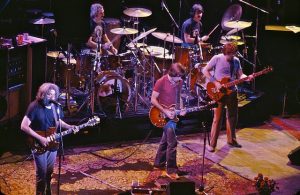
The Dead began in the early 70’s to develop a cult following (known as “Deadheads”) that grew to huge proportions. Many of these fans spent years of their lives following the band on tour, some of them making a living by selling Grateful dead merchandise in the parking lots of the venues where the band played. The band also allowed bootlegging (audience recording) and certain concert tapes of especially brilliant live performances were sometimes prized more than the actual albums. While most artists were not fond of bootlegging, this proved a way for the band to advertise their music and live performances for free, and often new fans were born out of hearing a friend’s live tape. The Dead, almost from the beginning, emphasized live performance as their primary vessel for artistic expression much more than studio recordings, and this was not lost on their fans.
The group was dealt a blow in 1986 when Jerry Garcia nearly died after falling into a coma. Garcia had to relearn how to play guitar before they could continue touring. Though the Grateful Dead continued to successfully tour and release albums with a huge live following, Jerry Garcia struggled with health problems and drug addiction until his death in 1995.
Listening Examples 13.1
Jefferson Airplane:
Grateful Dead:
- “Dark Star” live February 1969
- “Dark Star” live from 1974
- “Friend of the Devil” (from American Beauty 1970)
- “Friend of the Devil” live 1990
- Musical characteristics of the Grateful Dead by Todd Smith
The Doors
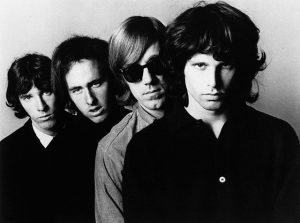
The Doors were an important psychedelic rock band from Los Angeles. The group consisted of Jim Morrison (Vocals), Ray Manzarek (Keyboards), Robby Krieger (Guitar), and John Densmore (Drums). Their name comes from The Doors of Perception, a book about the influence of drugs. Morrison was primarily a poet rather than a singer, and the band would set his poetry to music.
Though they gained a large fanbase, Morrison’s behavior was too erratic and influenced by drugs and alcohol to tour reliably. He was arrested in 1969 for lewd behavior onstage, and the band was forced to take a break. When they returned, they performed occasionally, but after releasing their final album LA Woman, Morrison left for Paris where he died of a heart attack.
Jimi Hendrix
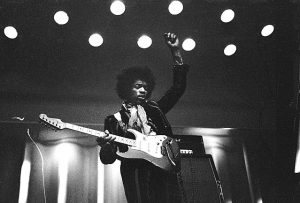
Jimi Hendrix – (1942-1970) Was equally important to the blues revival of the 1960s as he was to psychedelic rock. He emphasized a blues based guitar style coupled with innovative sounds such as intentional use of feedback and use of the whammy bar on the Fender Stratocaster guitar to create “Dive bomb” effects. The timbre of his instrument utilized “overdrive”, the sound where the tone of the guitar begins to break up and distort, somewhat similar to the “fuzz tone” effect used by groups like the Kinks and the Rolling Stones. This sound was being utilized by many different bluesmen but Hendrix increased the intensity by simply using louder amplifiers and turning them up louder.
Hendrix was inspired by blues guitarists like B.B. King, T-Bone Walker, and Muddy Waters. He played in various bands (including Little Richard’s band) until Chas Chandler of The Animals heard him in 1966 and took him back to England to help him expose his talents to a new audience. There Hendrix formed the Jimi Hendrix Experience, a trio with English players Noel Redding (Bass) and Mitch Mitchell (Drums). As he gained success in England, impressing Eric Clapton among many others, he came back to America to perform at the Monterey Pop Festival in 1967. This performance was the first time most Americans had seen him, and his popularity boosted as a result. He finished the performance by lighting his guitar on fire.
Hendrix dissolved the Experience in 1968 and moved to New York City to build his own studio which was called Electric Ladyland. A variety of musicians filtered in and out of Hendrix’s band around this time, including the members of the Band of Gypsys.
His performance is often cited as the peak of the Woodstock festival in 1969, specifically his rendition of the Star Spangled Banner, which made innovative use of feedback and squeals (Featured below). Hendrix died in September 1970, overdosing on barbiturate drugs. His legacy remains as one of the most influential musicians of all time.
Listen to Jimi Hendrix’s version of the Star Spangled Banner below. Notice specifically the unusual and intense sounds he gets from his instrument. Hendrix controls the electronic feedback and incorporates the sound into the music. Feedback is an electronic squeal inherent in amplified electronics that was for decades considered undesirable until artists like the Beatles, the Who, and Hendrix began using in a purposeful way. Also notice the way he uses the “Whammy Bar”, a bar that, when pressed down, loosens the guitar strings and lowers the pitch of the instrument. Originally intended for subtle variations in the pitch, Hendrix uses the bar in a very dramatic and extreme fashion. These sounds reflect the chaotic state of the nation in 1969, emulating the sounds of screams, protests, war, etc.
Listening Examples 13.2
Jimi Hendrix: First, listen to the what is known as the height of Hendrix’s performance at Monterey where he performs “Wild Thing” and he sets his guitar on fire! “Rock Me Baby” (live at Monterey Pop in 1967) is a blues standard by B.B. King that showcases Jimi’s heavy riff-based interpretation of the blues. Finally, listen to him perform “Star Spangled Banner” live at Woodstock August 1969.
Janis Joplin
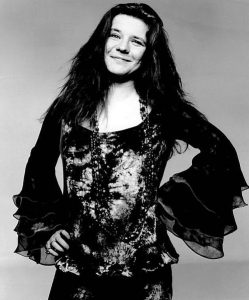
Janis Joplin – (1943-1970) was a singer/songwriter and important part of the blues revival in America. Originally from Texas, she eventually moved to San Francisco in the 1960s. Joplin was influenced by blues, gospel, and soul music, and her voice was utterly unique, rough and somewhat like a female version of Howlin’ Wolf.
In 1966 she joined the psychedelic rock band Big Brother and the Holding Company. Like many other groups such as the Who, the Jimi Hendrix Experience, and the Grateful Dead, Big Brother and the Holding Company had their breakthrough performance at the Monterey Pop Festival in 1967. The band released their second album Cheap Thrills in 1968 and it went to No. 1 on the pop charts.
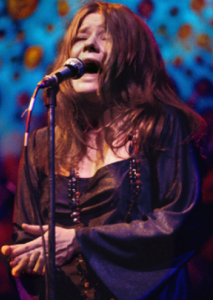
Joplin left the group in late 1968 and formed a new backing group called the Kozmic Blues Band which included a horn section. This group was less psychedelic and experimental. Rather, it was much more rooted in blues and soul music Around this time Joplin was deep into a heroin addiction, among other drug addictions such as alcohol. In fall of 1970 she died of an overdose of heroin.
The Band

The Band began as the backing band for Ronnie Hawkins, a rock and roll singer around 1960. The group was called The Hawks. Hawkins met drummer Levon Helm in Arkansas and Helm soon joined the Hawks. The band moved to Ontario, Canada where the rest of the members (who, with the exception of Helm, are all Canadian) eventually joined the Hawks. The members were: Robbie Robertson (guitar/primary songwriter), Richard Manuel (piano/drums/vocals), Levon Helm (drums/mandolin/vocals), Rick Danko (bass/violin/vocals) and Garth Hudson (organ/saxophone).
In 1964, the group left to perform on their own, and came to fame when Bob Dylan hired them as his backing band when he began playing electric music. They performed with Dylan in 1965-66, often to angry audiences who felt Dylan had betrayed them, and tainted the ‘purity’ of folk music. When Dylan was injured in a motorcycle accident in 1966, the group began working on their own material and releasing albums under the name “The Band”.
They soon settled into a style of their own blend of Americana combining folk, country and rock, and the first album includes the classic song “The Weight”. The band is notable for having 3 distinct lead singers who shared vocal duties which wasn’t common at the time with the exception of a few groups including the Beatles. The group performed at Woodstock and continued to tour and release albums through the first half of the 1970s, but began to grow weary of life on the road. Eventually the decision was reached to stop performing/touring.
They stopped performing together in 1976 after a massive farewell concert filmed by Martin Scorcese they called The Last Waltz. The film is considered by many to be on of the finest concert films of all time. The guests were abundant and showed the respect felt in the music community for The Band. They included Bob Dylan, Neil Young, Joni Mitchell, Neil Diamond, Ringo Starr, Eric Clapton, and Muddy Waters among many others.
Pink Floyd
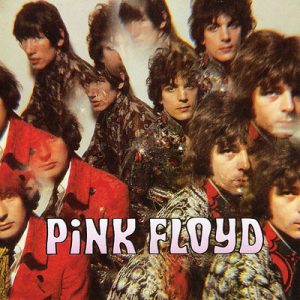
Pink Floyd initially gained success as a psychedelic rock group from England in the mid-1960s before their progressive rock heyday. Originally led by singer/guitarist and primary songwriter Syd Barret, they had a unique dreamy sounding brand of psychedelic rock. The music combines combines catchy melodies and danceable beats with surreal lyrics and unique instrumental sounds/effects including echo, fuzz tone guitars, pitch modulated pianos/keyboards, and spacey slide guitar.
In 1967 they released their first album Piper at the Gates of Dawn, but around this time Syd Barret began exhibiting bizarre and erratic behavior due to emerging mental illness exacerbated by frequent drug use. Barret left the group in 1968 and David Gilmour took his place, and the band took a new direction though much of their lyrical content was inspired by Barret’s mental illness. Barret released some solo material soon after, but spent most of the rest of his life as a recluse.
The song “See Emily Play” is one of their best known from the Barret-led era of the band. The lyrics are featured below and the song can be found in Listening Examples 13.3.
Emily tries but misunderstands, ah ooh
She’s often inclined to borrow somebody’s dreams till tomorrow
There is no other day
Let’s try it another way
You’ll lose your mind and play
Free games for May
See Emily play
Soon after dark Emily cries, ah ooh
Gazing through trees in sorrow hardly a sound till tomorrow
There is no other day
Let’s try it another way
You’ll lose your mind and play
Free games for May
See Emily play
Put on a gown that touches the ground, ah ooh
Float on a river forever and ever, Emily (Emily)
There is no other day
Let’s try it another way
You’ll lose your mind and play
Free games for May
See Emily play
Listening Examples 13.3
Janis Joplin: Notice the aggressive raspiness of Joplin’s voice in “Maybe”, reminiscent of Howlin’ Wolf and Little Richard, and also notice the gospel and soul characteristics of her singing. Here is the same song live.
The Band:“The Night They Drove Old Dixie Down” features lead vocals by Levon Helm, whose unmistakable Arkansas accent adds a feeling of authenticity to the music in relation to the lyrics. Lyrically, the song explores the hardships during the Civil War of a person from the Southern perspective.
Pink Floyd:“See Emily Play” (1967)
Mothers of Invention: “Who Needs the Peace Corps?” A cynical commentary on the counter culture from the Mothers of Invention led by Frank Zappa. Not all young musicians were singing the praises of the counter-culture, as Zappa saw hypocrisy in the behavior of many young people at the time.


